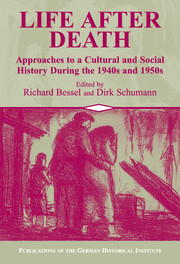Book contents
- Frontmatter
- Introduction Violence, Normality, and the Construction of Postwar Europe
- 1 Post-Traumatic Stress Disorder and World War II
- 2 Between Pain and Silence
- 3 Paths of Normalization after the Persecution of the Jews
- 4 Trauma, Memory, and Motherhood
- 5 Memory and the Narrative of Rape in Budapest and Vienna in 1945
- 6 “Going Home”
- 7 Desperately Seeking Normality
- 8 Family Life and “Normality” in Postwar British Culture
- 9 Continuities and Discontinuities of Consumer Mentality in West Germany in the 1950s
- 10 “Strengthened and Purified Through Ordeal by Fire”
- 11 The Nationalization of Victimhood
- 12 Italy after Fascism
- 13 The Politics of Post-Fascist Aesthetics
- 14 Dissonance, Normality, and the Historical Method
- Index
6 - “Going Home”
The Personal Adjustment of British and American Servicemen after the War
Published online by Cambridge University Press: 05 January 2013
- Frontmatter
- Introduction Violence, Normality, and the Construction of Postwar Europe
- 1 Post-Traumatic Stress Disorder and World War II
- 2 Between Pain and Silence
- 3 Paths of Normalization after the Persecution of the Jews
- 4 Trauma, Memory, and Motherhood
- 5 Memory and the Narrative of Rape in Budapest and Vienna in 1945
- 6 “Going Home”
- 7 Desperately Seeking Normality
- 8 Family Life and “Normality” in Postwar British Culture
- 9 Continuities and Discontinuities of Consumer Mentality in West Germany in the 1950s
- 10 “Strengthened and Purified Through Ordeal by Fire”
- 11 The Nationalization of Victimhood
- 12 Italy after Fascism
- 13 The Politics of Post-Fascist Aesthetics
- 14 Dissonance, Normality, and the Historical Method
- Index
Summary
War requires some men to commit acts of exceptional violence. They are sent to the front lines not primarily to die for their country, but to kill for it. They are executioners as well as victims, and, as such, inspire fear. For all men - whether they belong to the minority who are required to engage in front-line combat or whether they are the majority working behind the scenes in “support roles” - war disrupts lives in unprecedented ways. Without a doubt, the experience of combat during World War II had a permanent effect on its British and American participants. But what was the nature of this “impact” on combatants? Although historians have analyzed the political and social impact of the war, the psychological impact has been explored less frequently. Despite the difficulties involved in analyzing the copious number of accounts about the war of 1939-45 and its aftermath, it is crucial that an attempt be made to examine the ways in which servicemen themselves attempted to create and recreate themselves upon returning home.
Indisputably, combat experiences were powerful ones - and not wholly negative. Most combatants were able to find positive sides to their war. They frequently describe deep friendships and the excitement of travel. There was virile beauty in much of the technology of war. Even the act of fighting was often said to be thrilling, even sexually so. The removal of souvenirs from the bodies of their victims was indulged in as a way of prolonging the memories of the joys of combat long after the conflict had ended.
- Type
- Chapter
- Information
- Life after DeathApproaches to a Cultural and Social History of Europe During the 1940s and 1950s, pp. 149 - 160Publisher: Cambridge University PressPrint publication year: 2003
- 2
- Cited by



